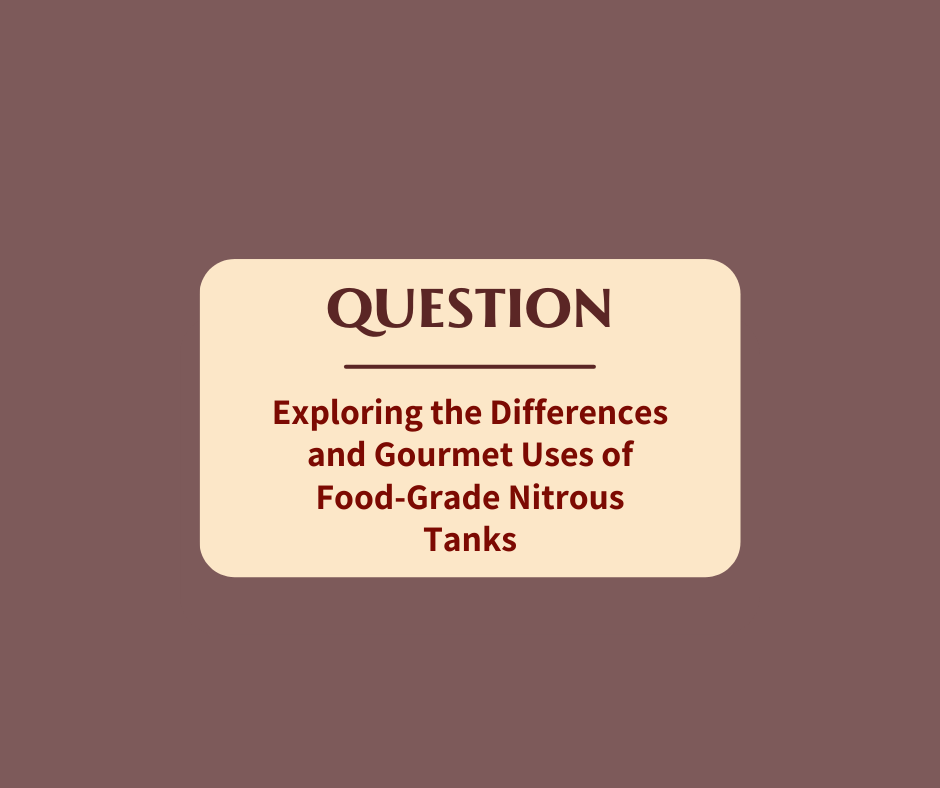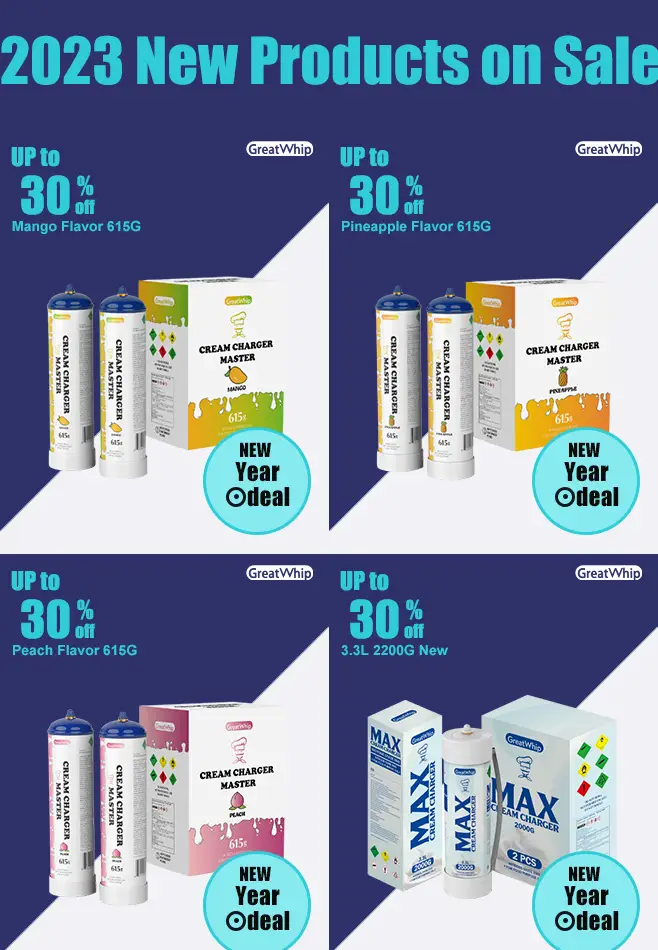If you’re a food enthusiast, you may have heard of food-grade nitrous tanks and their potential use in gourmet cuisine. These tanks are commonly used to create foams, infusions, and other culinary creations that add flair to dishes. However, many people wonder whether there are significant differences between food-grade and medical-grade nitrous oxide. In this article, we’ll explore the key differences between the two and highlight some of the gourmet uses of food-grade nitrous tanks.
The Differences Between Food Grade and Medical Nitrogen Oxide
Have you ever wondered about the nitrogen oxide used in the food industry and medical applications? Nitrogen oxide, or Nox, is a colorless and odorless gas that plays a vital role in various industries. However, not all nitrogen oxide is created equal. Two common types of nitrogen oxide – food grade and medical grade – differ in their purity, impurities, production, uses, and regulations. In this section, we will explore the differences between food-grade and medical-grade nitrogen oxide in detail, so you can better understand how they are used and why their differences matter.
Purity Level
Their different purity levels distinguish food-grade nitrogen oxide and medical-grade nitrogen oxide. Food-grade nitrogen oxide is used in the food industry, where its purity level is typically required to be at least 99.5%. It can contain up to 0.5% of other gases or impurities. However, the purity level for medical-grade nitrogen oxide is much higher, with a minimum requirement of 99.9%. This purity level ensures that the gas is free of any harmful contaminants that could adversely affect human health. High purity is critical for medical applications, where any impurities could have severe consequences.
Impurities
Food-grade nitrous oxide may contain small amounts of impurities, which are safe for consumption. These impurities include oxygen, carbon dioxide, and water, often in the air. These impurities do not risk human health when used in the food industry. However, medical-grade nitrogen oxide must be free of any contaminants that could be harmful to human health. Any impurities could cause respiratory problems and, in severe cases, death. Therefore, medical-grade nitrogen oxide is subject to strict regulations to ensure it is free of harmful impurities.
Production and Handling
Food-grade and medical-grade nitrogen oxide are produced using similar processes, which involve compressing and cooling air, then separating nitrogen and oxygen through cryogenic distillation. However, medical-grade nitrogen oxide requires additional purification steps and strict quality control measures to ensure its safety for medical use. The production process for medical-grade nitrogen oxide is subject to more stringent regulations than food-grade nitrogen oxide. Also, handling and storing medical-grade nitrogen oxide require specialized procedures to prevent contamination and ensure its safety.
Uses
Food-grade nitrogen oxide is commonly used in the food industry as a fuel for whipped cream and packaging and preservation of food products. It is also used in the wine industry to prevent oxidation and maintain the freshness of the wine. On the other hand, medical-grade nitrogen oxide is used in various medical applications, including anesthesia, respiratory therapy, and as a treatment for pulmonary hypertension. Nitrogen oxide is also used in dentistry to help patients relax during procedures.
Regulations
Food-grade and medical-grade nitrogen oxide are subject to regulations and standards set by government agencies such as the FDA and EPA. However, the rules for medical-grade nitrogen oxide are more stringent due to its use in medical applications and potential risks to human health. The production, storage, and transportation of medical-grade nitrogen oxide are subject to strict guidelines to ensure its safety for human use.
Container and Labeling Requirements
Food-grade nitrogen oxide may be stored in containers of various materials, such as steel or aluminum, and is often labeled for food use. However, medical-grade nitrogen oxide must be stored in specific containers that meet safety and quality standards, such as aluminum cylinders. It must be labeled with information regarding its purity, production date, and expiration date. The labeling requirements for medical-grade nitrogen oxide are more stringent than those for food-grade nitrogen oxide, as it is crucial to ensure its safety during medical use.
Handling and Transportation Regulations
Food-grade nitrogen oxide is transported and handled using standard safety practices and guidelines. However, medical-grade nitrogen oxide requires specialized handling and transportation procedures, including proper ventilation and secure storage, to prevent contamination or safety hazards. The handling and transportation of medical-grade nitrogen oxide are subject to strict regulations to ensure its safety during transit.
Cost
Due to the higher purity and additional quality control measures required for medical-grade nitrogen oxide, it is typically more expensive than food-grade nitrogen oxide. The higher cost of medical-grade nitrogen oxide is due to the stringent regulations and quality control measures necessary to ensure its safety for medical use. These measures involve extensive testing, monitoring, and documentation to ensure the nitrogen oxide meets the required purity and safety standards.
In contrast, the production and quality control measures for food-grade nitrogen oxide are less strict, which makes it more cost-effective to produce and sell. Food-grade nitrogen oxide is primarily used in the food industry, where the demand for gas is high. Still, the purity requirements are lower compared to medical-grade nitrogen oxide.
Moreover, the cost of nitrogen oxide can also vary based on its availability, the volume of the purchase, and the supplier. Generally, the price of nitrogen oxide for medical use is higher due to the strict regulations and quality control measures involved. This adds to the overall cost of production and supply.
Gourmet Uses of Food-Grade Nitrous Tanks
In recent years, food-grade nitrous oxide tanks have become a popular tool for chefs and home cooks. The gas can create fluffy whipped cream, velvety sauces, and delicate foams, among other culinary applications. Here are some of the gourmet uses of food-grade nitrous tanks in more detail:
- Whipped Cream:Whipped cream is a classic dessert topping easily created with a food-grade nitrous tank. You can create a light and fluffy whipped cream in just a few seconds by using a mixture of heavy cream and sugar. To make it even more exciting, you can experiment with adding different flavors to the cream, such as vanilla or chocolate.
- Cocktails: Cocktails can be elevated to a new level using a food-grade nitrous tank. A nitrous-infused cocktail will have a light and airy texture and a foamy head, making it visually appealing and adding a new dimension of taste. You can experiment with different flavors, infusing fruits or herbs into the nitrous oxide to create unique cocktail concoctions.
- Sauces: Nitrous tanks can also create smooth and velvety sauces. You can create a delicious hollandaise sauce by combining egg yolks, butter, and lemon juice. Adding nitrous oxide will give the sauce a light and fluffy texture that is perfect for drizzling over eggs benedict or asparagus.
- Foams: Food-grade nitrous tanks are also commonly used to create foams, which can be used as a garnish or topping for various dishes. For example, a potato foam can be made by combining potatoes, butter, and cream and using a nitrous tank to aerate the mixture. This foam can then be used as a soups topping or a side dish.
- Infusions: Food-grade nitrous tanks can also infuse flavors into liquids. For example, you can create a nitrous-infused coffee by adding coffee grounds to the tank and infusing the gas into the liquid. This will create a carbonated coffee that is rich and flavorful.
- Infused Oils and Vinegar: Food-grade nitrous tanks can infuse oils and vinegar with different flavors. Combining your desired ingredients, such as herbs or fruits, with the oil or vinegar in the tank, and infusing the gas, create a unique and flavorful dressing or marinade.
- Carbonated Fruit: Food-grade nitrous tanks can also be used to carbonate fruits. Nurturing nitrous oxide into the fruit will become carbonated and have a fizzy texture. This can be a fun and unique way to add a twist to fruit salads or garnishes.
- Aeration: Food-grade nitrous tanks can aerate different ingredients, such as cream cheese or mayonnaise. This process will make these ingredients lighter and fluffier, creating a unique texture for sandwiches or spreads.
- Frozen Treats: Nitrous oxide can also create frozen treats like ice cream or sorbet. Using a combination of cream, sugar, and nitrous oxide in a food-grade tank can create a smooth and creamy frozen dessert in a matter of seconds.
- Molecular Gastronomy:Nitrous oxide is commonly used in molecular gastronomy, a type of cooking that uses science and technology to create unique culinary experiences. Food-grade nitrous tanks develop unique textures and flavors in molecular gastronomy, such as foams, gels, and air. This technique is often used in high-end restaurants to create a unique dining experience for their customers.
Advice on the Use of Food-Grade Nitrous Tank
If you’re considering using a food-grade nitrous oxide tank in your kitchen, taking a few precautions is essential to ensure that you use it safely and effectively. Here is some advice on the use of food-grade nitrous tanks.
Read the Instructions Carefully
Before using a food-grade nitrous tank, it’s essential to read the instructions carefully. This will help you understand how to handle the tank safely and effectively. The instructions will usually include information on how to store the tank properly, connect the valve, adjust the flow rate, and clean the tank after use. Failure to follow the instructions can damage the tank or even cause injury.
Store the Tank Properly
Storing a food-grade nitrous tank properly is crucial to ensure its longevity and prevent any accidents. It’s important to store the tank in a cool, dry, well-ventilated area away from direct sunlight and heat sources. It’s also best to store the tank upright to prevent the nitrous oxide from leaking out.
Don’t Overfill the Tank
Overfilling a food-grade nitrous tank can cause it to rupture or explode, which can be extremely dangerous. To avoid overfilling, always use a digital scale or a tank pressure gauge to measure the amount of nitrous oxide you put into the tank. Follow the manufacturer’s guidelines for the maximum amount of nitrous oxide added to the tank.
Wear Protective Gear
When using a food-grade nitrous tank, it’s essential to wear protective gear such as gloves and eye protection. Nitrous oxide is extremely cold and can cause frostbite or skin irritation if it comes into contact with your skin. It’s also essential to wear eye protection to prevent any splashes of nitrous oxide from getting into your eyes.
Use the Tank in a Well-Ventilated Area
Nitrous oxide is a colorless and odorless gas that can accumulate in poorly ventilated areas, which can be dangerous. Using the tank in a well-ventilated area, such as a kitchen with an open window or a range hood, is essential. If you’re using the tank in a confined space, use a fan to circulate the air and prevent any gas buildup.
Don’t Inhale the Gas
Nitrous oxide is commonly known as “laughing gas” and can cause a feeling of euphoria and dizziness if inhaled in large quantities. However, inhaling nitrous oxide can be dangerous and cause headaches, nausea, and even loss of consciousness. To avoid risks, never inhale the gas directly from the tank or use the tank in an enclosed space where the gas can accumulate.
Final Thought
While food-grade and medical-grade nitrous oxide may seem similar on the surface, there are significant differences to remember. Food-grade nitrous tanks are designed for culinary applications and are held to higher safety and quality standards. They offer a range of creative possibilities for enhancing dishes and can be a fun addition to any home kitchen or professional restaurant. However, it’s crucial to follow safety guidelines when using these tanks and handle them carefully. By doing so, you can confidently and creatively explore the world of gourmet cooking.








